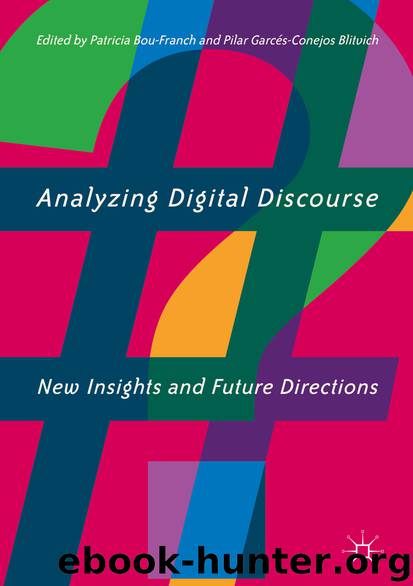Analyzing Digital Discourse by Patricia Bou-Franch & Pilar Garcés-Conejos Blitvich

Author:Patricia Bou-Franch & Pilar Garcés-Conejos Blitvich
Language: eng
Format: epub
ISBN: 9783319926636
Publisher: Springer International Publishing
7.3 Online Consumer Reviews and Their Parodies
As an exemplar of participatory culture (Jenkins, 2006), the user-generated online consumer review has evolved over the last decade, into a global, widespread genre of digital communication. Research interest in the topic of online consumer reviews has been growing as well, with an increasing number of publications found across a wide variety of disciplines, including marketing, economics, computer science—and, more recently, discourse studies. As discourse analytic research about online review language has shown, this digital genre is a distinctive one, owing to the ways in which authors of online reviews claim particular identities (Mackiewicz, 2010a, 2010b) in the typical forms of evaluation they use (Skalicky, 2013; Taboada, 2011; Tian, 2013), in how they create and represent audience involvement (Vásquez, 2012, 2015), as well as in their intertextual and narrative practices (Jurafsky, Chahuneau, Routledge, & Smith, 2014; Vásquez, 2014).
In earlier work (Vásquez, 2014), we identified several features shared by 1000 online reviews sampled from various websites, including Amazon. Among these features were the discursive constructions of specific, context-relevant reviewer identities. Research on reviews has shown that many review writers claim situationally relevant identities in order to establish their credibility, and to provide review readers with additional context for interpreting the evaluative claims made within a review. Both gender and family roles and relationships have been identified as some of the most common demographic or membership categories that authors of online reviewers inscribe into their review texts.
As online reviews have become established as a genre of CMC , and have continued to grow both in their number and their influence over the last decade, parodies of the genre have increasingly appeared on popular review sites (such as Amazon), alongside legitimate reviews. Addressing the question of differences between parodic and nonparodic Amazon reviews, a recent corpus-based analysis (Skalicky & Crossley, 2015) compared a sample of 375 parody reviews with a similar sample of legitimate reviews. The analysis of lexical, grammatical, and semantic features found that the parodic texts were characterized by significantly higher frequencies of past tense words, as well as significantly higher levels of word concreteness. Just as authors of legitimate reviews inscribe their social identities into their texts, authors of review parodies also provide various types of discursively constructed “personal” information. This performed self-disclosure serves two functions in parody texts: it mimics a discourse convention that appears in legitimate Amazon reviews, and it also functions as an anchoring device for the unusual or improbable events which are presented within the narrative texts.
Another recent study (Ray, 2016) has also taken a corpus approach to examining the language of parody reviews. Ray’s analysis centered on the notion of “stylization” and the gender stereotypes found in Amazon reviews of one popularly parodied product: Bic for Her Pens. While scholars from other disciplines have begun to notice that “there is, in fact, a thriving and popular genre of humorous Amazon reviewing” (Kozinets, 2016, p. 836), Ray’s study represents a unique contribution because it moves beyond the humorous aspect of parody and recognizes its potential for social critique.
Download
This site does not store any files on its server. We only index and link to content provided by other sites. Please contact the content providers to delete copyright contents if any and email us, we'll remove relevant links or contents immediately.
Algorithms of the Intelligent Web by Haralambos Marmanis;Dmitry Babenko(9832)
Test-Driven Development with Java by Alan Mellor(7661)
Data Augmentation with Python by Duc Haba(7544)
Principles of Data Fabric by Sonia Mezzetta(7319)
Learn Blender Simulations the Right Way by Stephen Pearson(7236)
Microservices with Spring Boot 3 and Spring Cloud by Magnus Larsson(7071)
RPA Solution Architect's Handbook by Sachin Sahgal(6461)
Jquery UI in Action : Master the concepts Of Jquery UI: A Step By Step Approach by ANMOL GOYAL(6447)
The Infinite Retina by Robert Scoble Irena Cronin(6171)
Hadoop in Practice by Alex Holmes(6138)
Big Data Analysis with Python by Ivan Marin(5886)
Life 3.0: Being Human in the Age of Artificial Intelligence by Tegmark Max(5474)
Pretrain Vision and Large Language Models in Python by Emily Webber(4843)
Infrastructure as Code for Beginners by Russ McKendrick(4625)
WordPress Plugin Development Cookbook by Yannick Lefebvre(4343)
Functional Programming in JavaScript by Mantyla Dan(4216)
The Age of Surveillance Capitalism by Shoshana Zuboff(4210)
Embracing Microservices Design by Ovais Mehboob Ahmed Khan Nabil Siddiqui and Timothy Oleson(4114)
Applied Machine Learning for Healthcare and Life Sciences Using AWS by Ujjwal Ratan(4094)
